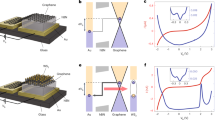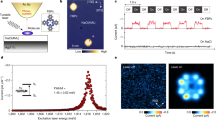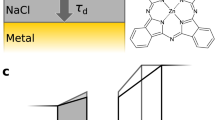Abstract
Experimental mapping of transmission is essential for understanding and controlling charge transport through molecular devices and materials. Here we developed a single-molecule photoelectron tunnelling spectroscopy approach for mapping transmission beyond the HOMO–LUMO gap of the single diketopyrrolopyrrole molecule junction using an ultrafast-laser combined scanning tunnelling microscope-based break junction set-up at room temperature. Two resonant transport channels of ultrafast photocurrent are found by our photoelectron tunnelling spectroscopy, ranging from 1.31 eV to 1.77 eV, consistent with the LUMO + 1 and LUMO + 2 in the transmission spectrum obtained by density functional theory calculations. Moreover, we observed the modulation of resonant peaks by varying bias voltages, which demonstrates the ability to quantitatively characterize the effect of the electric field on frontier molecular orbitals. Our single-molecule photoelectron tunnelling spectroscopy offers an avenue that allows us to explore the nature of energy-dependent charge transport through single-molecule junctions.
This is a preview of subscription content, access via your institution
Access options
Access Nature and 54 other Nature Portfolio journals
Get Nature+, our best-value online-access subscription
$29.99 / 30 days
cancel any time
Subscribe to this journal
Receive 12 print issues and online access
$259.00 per year
only $21.58 per issue
Buy this article
- Purchase on Springer Link
- Instant access to full article PDF
Prices may be subject to local taxes which are calculated during checkout



Similar content being viewed by others
Data availability
The main data supporting the findings of this study are provided with this paper. Source data are provided with this paper.
Code availability
The data analysis of conductance measurements was performed using our open-source code XME analysis, which is available at https://github.com/Pilab-XMU/XMe_DataAnalysis. The computation details are available from the corresponding authors upon request.
References
Bai, J. et al. Anti-resonance features of destructive quantum interference in single-molecule thiophene junctions achieved by electrochemical gating. Nat. Mater. 18, 364–369 (2019).
Tang, C. et al. Reversible switching between destructive and constructive quantum interference using atomically precise chemical gating of single-molecule junctions. J. Am. Chem. Soc. 143, 9385–9392 (2021).
Greenwald, J. E. et al. Highly nonlinear transport across single-molecule junctions via destructive quantum interference. Nat. Nanotechnol. 16, 313–317 (2021).
Song, H. et al. Observation of molecular orbital gating. Nature 462, 1039–1043 (2009).
Capozzi, B. et al. Mapping the transmission functions of single-molecule junctions. Nano Lett. 16, 3949–3954 (2016).
Beebe, J. M., Kim, B., Gadzuk, J. W., Daniel Frisbie, C. & Kushmerick, J. G. Transition from direct tunneling to field emission in metal-molecule-metal junctions. Phys. Rev. Lett. 97, 026801 (2006).
Bâldea, I. Interpretation of stochastic events in single-molecule measurements of conductance and transition voltage spectroscopy. J. Am. Chem. Soc. 134, 7958–7962 (2012).
Guo, S., Zhou, G. & Tao, N. Single molecule conductance, thermopower, and transition voltage. Nano Lett. 13, 4326–4332 (2013).
Reddy, P., Jang, S.-Y., Segalman Rachel, A. & Majumdar, A. Thermoelectricity in molecular junctions. Science 315, 1568–1571 (2007).
Bai, J., Li, X., Zhu, Z., Zheng, Y. & Hong, W. Single-molecule electrochemical transistors. Adv. Mater. 33, e2005883 (2021).
Ke, G., Duan, C., Huang, F. & Guo, X. Electrical and spin switches in single-molecule junctions. InfoMat. 2, 92–112 (2020).
Ting, T.-C. et al. Energy-level alignment for single-molecule conductance of extended metal-atom chains. Angew. Chem. 127, 15960–15964 (2015).
Liu, H., Zhang, H., Zhao, Y., Liu, J. & Hong, W. Interface engineering for single-molecule devices. Trends Chem. 5, 367–379 (2023).
Zang, Y. P. et al. Resonant transport in single diketopyrrolopyrrole junctions. J. Am. Chem. Soc. 140, 13167–13170 (2018).
Li, S. S. et al. Transition between nonresonant and resonant charge transport in molecular junctions. Nano Lett. 21, 8340–8347 (2021).
Reddy, H. et al. Determining plasmonic hot-carrier energy distributions via single-molecule transport measurements. Science 369, 423–426 (2020).
Gutzler, R., Garg, M., Ast, C. R., Kuhnke, K. & Kern, K. Light–matter interaction at atomic scales. Nat. Rev. Phys. 3, 441–453 (2021).
Du, S., Yoshida, K., Zhang, Y., Hamada, I. & Hirakawa, K. Terahertz dynamics of electron–vibron coupling in single molecules with tunable electrostatic potential. Nat. Photonics 12, 608–612 (2018).
Imai-Imada, M. et al. Orbital-resolved visualization of single-molecule photocurrent channels. Nature 603, 829–834 (2022).
Garg, M. & Kern, K. Attosecond coherent manipulation of electrons in tunneling microscopy. Science 367, 411–415 (2020).
Yoshioka, K. et al. Real-space coherent manipulation of electrons in a single tunnel junction by single-cycle terahertz electric fields. Nat. Photonics 10, 762–765 (2016).
Kazuma, E., Jung, J., Ueba, H., Trenary, M. & Kim, Y. Real-space and real-time observation of a plasmon-induced chemical reaction of a single molecule. Science 360, 521–525 (2018).
Hu, Y. et al. Single dynamic covalent bond tailored responsive molecular junctions. Angew. Chem. Int. Ed. 60, 20872–20878 (2021).
Tang, C. et al. Multicenter-bond-based quantum interference in charge transport through single-molecule carborane junctions. Angew. Chem. Int. Ed. 58, 10601–10605 (2019).
Hong, W. J. et al. Single molecular conductance of tolanes: experimental and theoretical study on the junction evolution dependent on the anchoring group. J. Am. Chem. Soc. 134, 2292–2304 (2012).
Tan, Z. et al. The control of intramolecular through-bond and through-space coupling in single-molecule junctions. CCS Chem. 3, 929–937 (2021).
Terada, Y., Yoshida, S., Takeuchi, O. & Shigekawa, H. Real-space imaging of transient carrier dynamics by nanoscale pump-probe microscopy. Nat. Photonics 4, 869–874 (2010).
Zhan, C. et al. Single-molecule plasmonic optical trapping. Matter 3, 1350–1360 (2020).
Kos, D., Assumpcao, D. R., Guo, C. Y. & Baumberg, J. J. Quantum tunneling induced optical rectification and plasmon-enhanced photocurrent in nanocavity molecular junctions. ACS Nano 15, 14535–14543 (2021).
Schröder, B. et al. Controlling photocurrent channels in scanning tunneling microscopy. New J. Phys. 22, 033047 (2020).
Lindstrom, C. D. & Zhu, X. Y. Photoinduced electron transfer at molecule–metal interfaces. Chem. Rev. 106, 4281–4300 (2006).
Li, Z. et al. Understanding the conductance dispersion of single-molecule junctions. J. Phys. Chem. C 125, 3406–3414 (2021).
Quan, R., Pitler, C. S., Ratner, M. A. & Reuter, M. G. Quantitative interpretations of break junction conductance histograms in molecular electron transport. ACS Nano 9, 7704–7713 (2015).
Adak, O., Korytár, R., Joe, A. Y., Evers, F. & Venkataraman, L. Impact of electrode density of states on transport through pyridine-linked single molecule junctions. Nano Lett. 15, 3716–3722 (2015).
Parker, C. R. et al. A comprehensive study of extended tetrathiafulvalene cruciform molecules for molecular electronics: synthesis and electrical transport measurements. J. Am. Chem. Soc. 136, 16497–16507 (2014).
Li, Y. et al. Interplay of bias-driven charging and the vibrational Stark effect in molecular junctions. Nano Lett. 16, 1104–1109 (2016).
Huang, X. Y. et al. Electric field-induced selective catalysis of single-molecule reaction. Sci. Adv. 5, eaaw3072 (2019).
Abbasi, M., Evans, C. I., Chen, L. & Natelson, D. Single metal photodetectors using plasmonically-active asymmetric gold nanostructures. ACS Nano 14, 17535–17542 (2020).
Zolotavin, P., Evans, C. & Natelson, D. Photothermoelectric effects and large photovoltages in plasmonic Au nanowires with nanogaps. J. Phys. Chem. Lett. 8, 1739–1744 (2017).
Zhang, Y. C. et al. Surface-plasmon-driven hot electron photochemistry. Chem. Rev. 118, 2927–2954 (2018).
Baumberg, J. J., Aizpurua, J., Mikkelsen, M. H. & Smith, D. R. Extreme nanophotonics from ultrathin metallic gaps. Nat. Mater. 18, 668–678 (2019).
Brinks, D. et al. Ultrafast dynamics of single molecules. Chem. Soc. Rev. 43, 2476–2491 (2014).
de Nijs, B. et al. Plasmonic tunnel junctions for single-molecule redox chemistry. Nat. Commun. 8, 994 (2017).
Garg, M. et al. Real-space subfemtosecond imaging of quantum electronic coherences in molecules. Nat. Photonics 16, 196–202 (2022).
Katayama, I., Kimura, K., Imada, H., Kim, Y. & Takeda, J. Investigation of ultrafast excited-state dynamics at the nanoscale with terahertz field-induced electron tunneling and photon emission. J. Appl. Phys. 133, 110903 (2023).
Kaneko, S. et al. Site-selection in single-molecule junction for highly reproducible molecular electronics. J. Am. Chem. Soc. 138, 1294–1300 (2016).
Tachizaki, T., Hayashi, K., Kanemitsu, Y. & Hirori, H. On the progress of ultrafast time-resolved THz scanning tunneling microscopy. APL Mater. 9, 060903 (2021).
Smidstrup, S. et al. First-principles Green’s-function method for surface calculations: a pseudopotential localized basis set approach. Phys. Rev. B 96, 195309 (2017).
Smidstrup, S. et al. QuantumATK: an integrated platform of electronic and atomic-scale modelling tools. J. Phys. Condens. Matter 32, 015901 (2019).
Li, L. et al. Highly conducting single-molecule topological insulators based on mono- and di-radical cations. Nat. Chem. 14, 1061–1067 (2022).
Garner, M. H. et al. Comprehensive suppression of single-molecule conductance using destructive sigma-interference. Nature 558, 415–419 (2018).
Acknowledgements
This work was supported by the National Natural Science Foundation of China (numbers 22250003 (W.H.), 21722305 (W.H.), 22173075 (J.L.) and 21933012 (J.L.)) and the Fundamental Research Funds for the Central Universities (numbers 20720220020 (J.L.), 20720220072 (J.L.), 20720200068 (J.L.), 20720190002 (W.H.)). We thank K.-Q. Lin and J. Yi at Xiamen University for helpful discussions and Z. Luo at Xiamen University for providing the continuous-wave laser. We also acknowledge the support from the ultra-precision laboratory at IKKEM for offering the experimental platforms.
Author information
Authors and Affiliations
Contributions
W.H. supervised the project. W.H., Y.Y. and L.C. originally conceived the concept and designed the experiments. L.C., H.L., Z.Y., J.L. and J.S. designed and constructed the set-up. H.L., L.C. and H.Z. performed the experiments. C.F. and P.Z. performed the thermopower measurements. H.L. and L.C. conceived and developed the data analysis method. W.X. synthesized the molecules. J.Y. carried out the DFT calculations. H.L. and L.C. prepared the manuscript with input from other authors.
Corresponding author
Ethics declarations
Competing interests
The authors declare no competing interests.
Peer review
Peer review information
Nature Materials thanks Jun Takeda and the other, anonymous, reviewer(s) for their contribution to the peer review of this work.
Additional information
Publisher’s note Springer Nature remains neutral with regard to jurisdictional claims in published maps and institutional affiliations.
Supplementary information
Supplementary Information
Table of contents, Supplementary Discussion and Figs. 1–27.
Supplementary Data 1
The atomic coordinates of the optimized computational models.
Source data
Source Data Fig. 1
Statistical Source Data
Source Data Fig. 2
Statistical Source Data
Source Data Fig. 3
Statistical Source Data
Rights and permissions
Springer Nature or its licensor (e.g. a society or other partner) holds exclusive rights to this article under a publishing agreement with the author(s) or other rightsholder(s); author self-archiving of the accepted manuscript version of this article is solely governed by the terms of such publishing agreement and applicable law.
About this article
Cite this article
Liu, H., Chen, L., Zhang, H. et al. Single-molecule photoelectron tunnelling spectroscopy. Nat. Mater. 22, 1007–1012 (2023). https://doi.org/10.1038/s41563-023-01591-4
Received:
Accepted:
Published:
Issue Date:
DOI: https://doi.org/10.1038/s41563-023-01591-4
This article is cited by
-
Mapping frontier molecular orbitals using photocurrents
Science China Materials (2023)



